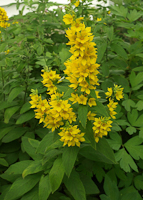| E-mail me at mcclainm@optonline.net | Visit my Facebook page | View my LinkedIn profile |
My Garden Plants
Michael L McClain
St James, NY
Garden Loosestrife
Lysimachia punctata

Easily grown in moist, humusy, well-drained soils in full sun to part shade. Plants prefer full sun in the northern part of their growing range, but appreciate some part afternoon shade in the St. Louis area. 'Alexander' is a patented cultivar that only occasionally produces seed, but will not come true from seed. Although it will spread by rhizomes to form colonies, it is much less aggressive in that regard than the species. Variegated foliage tends to brown at the edges when grown in soil that is too dry.
Noteworthy Characteristics: Lysimachia punctata is native to central/southern Europe and Turkey, but has over time escaped gardens throughout many parts of the northern U. S., particularly in the northeastern states, where it has naturalized in waste places, ditches and along roadsides. 'Alexander' is a patented cultivar featuring green and white variegated foliage that emerges in spring with pink tinges. It is a rhizomatous, clump-forming perennial that grows to 1-2' (less frequently to 3') tall on stiff upright stems clad with pubescent, ovate to lance-shaped leaves (to 3" long) in whorls of 3 or 4 (occasionally opposite). Leaves have distinctive green and white variegation. Cup-shaped, five-petalled, bright yellow flowers (to 1" across) in axillary whorls bloom from May to September. Plants in the genus Lysimachia are members of the primrose family and not the loosestrife family (Lythrum). Genus name honors Lysimachus (661-281 B.C.), Macedonian King of Thrace. U. S. Plant Patent PP10,598 issued September 8, 1998.
Problems: No serious insect or disease problems. Lysimachia is susceptible to rust and leaf spots.
Uses: Cottage gardens, wild gardens, borders, open woodland gardens, pool peripheries or along streams. Avoid planting near valuable perennials because of potential for rhizomatous spread.

I've had yellow loosestrife growing in the yard for years. There is some of it in the front next to the house, and some outside the fence near the front. This spring I transplanted it there. A few weeks ago, I planted stonecrop in front of it.